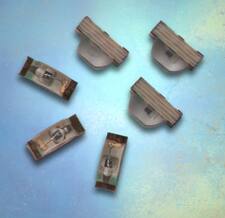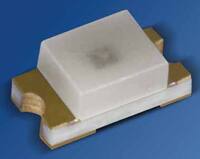ChipLED Solutions for Consumer, Industrial Applications
投稿人:电子产品
2012-05-22
Although chipLEDs were first developed about 10 years ago to meet the small-size, low-cost, and easy-assembly requirements for backlighting keypads in cellular phones and other consumer electronic products, these tiny devices are now being designed into white goods, industrial measurement systems, control systems, office equipment, and computer peripherals (providing symbol lighting and status indication).
"One of the major reasons why chipLEDs are used is because they are very small and take up very little board space," said Francis Nguyen, OSRAM Opto Semiconductors' senior product marketing manager for LEDs in Sunnyvale, CA. "When selecting a chipLED, designers want to look at how much space it takes up, then look at the brightness, color, and technology."
With chipLEDs, designers do not have to compromise on package size, color, or brightness. ChipLEDs combine industry-standard package sizes (0402, 0603, 0805, and 1206) with high light output, a range of colors, and several packaging options, delivering greater design flexibility. ChipLEDs are also available in bi- or tri-colors, but these require more board space.
Like other LEDs, chipLEDs are based on AlInGaP, GaP, and InGaN process technologies. AlInGaP and GaP LEDs are available in red, orange, amber, and yellow-green, while InGaN-based LEDs offer blue and white colors. These devices typically are available in top-mount, right-angle, and reverse-mount packaging options. Top mount is the most commonly specified due to its ease of use.
In general, GaP-based LEDs are the least expensive because of their lower brightness. For industrial applications, where color is not the primary driver, designers can choose a lower-cost GaP LED. The blue and white LEDs are generally the most expensive and are typically used as key product differentiators, meeting consumer expectations for a "cool" effect. Both AlInGaP and GaP LEDs offer a low forward voltage of about 2.1 V at 20 mA, while InGaN LEDs supply a higher forward voltage of about 3.2 or 3.3 V.
The LED brightness required in any application depends on the ambient lighting environment. For example, in an industrial machine or tool application where the ambient lighting is very bright, the designer will likely need a higher brightness (AlInGap) LED, but if the equipment is operating under normal ambient lighting, then it is very likely the designer can use a lower-cost GaN LED.
One of the things designers need to think about is how long the LED needs to remain in the "on" mode. In many applications, designers can take a mix-and-match approach if budgets are tight: use more robust LEDs for functions that require longer lifetimes such as power indicators and select chipLEDs for indicators that are not "on" all the time such as status indicators for paper jams or error buttons.
Boon-Keng Yeoh, product manager for chipLEDs at Avago Technologies in Malaysia, said good examples of industrial devices that can use chipLEDs include pick-and-place equipment, handheld measurement tools such as multimeters, and other test equipment.
Yeoh recommended that designers choose industrial footprint sizes that match all other components sizes. If the other components, including resistors and inductors, are all packaged in 0805 footprints, then designers should try to get all the devices to match so the pick-and-place equipment can handle them without a change of nozzle.
Look at the datasheet
A designer’s first stop in the chipLED selection process will be to review various supplier data sheets. As noted in Avago’s Surface Mount ChipLEDs Design Guide¹, chipLED device datasheets usually start with a brief selection and comparison table followed by Absolute Maximum Ratings and a presentation of the device’s Electrical/Optical Characteristics.
As an example, let’s look at the Absolute Maximum Ratings table at TA = 25°C for the Avago HSMF-C16x Miniature Bi-Color Surface Mount chipLEDs (Figure 1). This series of bi-color chipLEDs is designed to achieve high density of components on a board. They have the industry standard footprint of 1.6 mm x 0.8 mm and a height of only 0.5 mm. This makes them very suitable for cellular phone and mobile equipment backlighting and indication applications.
| Parameter | AllnGaP | InGaN | GaP | Units |
| DC Forward Current¹ | 20 | 10 | 20 | mA |
| Power Dissipation | 48 | 38 | 52 | mW |
| Reverse Voltage | 5 | 5 | 5 | V |
| LED Junction Temperature | 95 | 95 | 95 | °C |
| Operating Temperature Range | -40°C to +85°C | °C | ||
| Storage Temperature Range | -40°C to +85°C | °C | ||
| Soldering Temperature | See reflow soldering profile | |||
In Figure 1, the two criteria that establish the operating limits are the maximum drive currents and the absolute maximum LED junction temperature. The maximum drive currents have been established to ensure long operating life. The absolute maximum LED junction temperature is a device package limitation that must not be exceeded.
The LED junction temperature, TJ(°C), is the sum of the ambient temperature, TA(°C), and the temperature rise of the LED junction above ambient, ΔTJ(°C), which is the product of the power dissipated within the LED junction, PD(W), and the thermal resistance LED junction-to-ambient, RθJ-A(°C/W).
TJ = TA + ΔTJ
TJ = TA + PD x RθJ-A
The Electrical/Optical Characteristics at TA = 25°C (Figure 2, again for the Avago HSMF-C16x family) contains the electrical data and optical data that are used to determine the operating conditions for the device. The forward voltage, VF, and device thermal resistance Rθ J-PIN, used in operating condition calculations are listed in this table (Figure 2).
| Color | Forward Voltage VF (Volts) @ IF |
Typ. | Max. | Reverse Breakdown VR (Volts) @ IR = 100μA Min. |
Capacitance C(pF), @ VF = 0, f = 1 MHz Typ. |
Thermal Resistance RθJ-PIN (°C/W) Typ. |
| AllnGaP Red | 20 mA | 1.9 | 2.4 | 5 | 15 | 300 |
| AllnGaP Amber | 20 mA | 1.9 | 2.4 | 5 | 11 | 300 |
| AllnGaP Red | 10 mA | 1.8 | 2.3 | 5 | 15 | 300 |
| AllnGaP Amber | 10 mA | 1.8 | 2.3 | 5 | 11 | 300 |
| InGaN Green | 10 mA | 3.4 | 3.8 | 5 | 35 | 500 |
| InGaN Blue | 10 mA | 3.4 | 3.8 | 5 | 35 | 500 |
| HER | 20 mA | 2.1 | 2.6 | 5 | 5 | 325 |
| GaP Orange | 20 mA | 2.2 | 2.6 | 5 | 7 | 325 |
| GaP Yellow | 20 mA | 2.1 | 2.6 | 5 | 6 | 325 |
| GaP Green | 20 mA | 2.2 | 2.6 | 5 | 9 | 325 |
Figure 2: Electrical characteristics.
In the optical characteristics table (Figure 3), note that the luminous intensity Iv is measured at the peak of the spatial radiation pattern, which may not be aligned with the mechanical axis of the lamp and package. The dominant wavelength λd is derived from the CIE chromaticity diagram and represents the perceived color of the device. For the Viewing Angle column, also note that θ1/2 is the off-axis angle where the luminous intensity is half the peak intensity.
| Color | Luminous Intensity IV(mcd) @ IF |
Min. | Typ. | Peak Wavelength λpeak (nm) Typ. |
Color Dominant Wavelength λd (nm) Typ. |
Viewing Angle 2θ1/2 Degrees Typ. |
Luminous Efficacy ηV(Im/W) Typ. |
| AllnGaP Red | 20 mA | 28.5 | 90 | 637 | 626 | 120 | 155 |
| AllnGaP Amber | 20 mA | 28.5 | 90 | 595 | 592 | 120 | 480 |
| AllnGaP Red | 10 mA | 11.2 | 35 | 637 | 626 | 120 | 155 |
| AllnGaP Amber | 10 mA | 11.2 | 35 | 595 | 592 | 120 | 480 |
| InGaN Green | 10 mA | 18 | 45 | 523 | 525 | 120 | 500 |
| InGaN Blue | 10 mA | 2.8 | 10 | 468 | 470 | 120 | 80 |
| HER | 20 mA | 2.8 | 10 | 636 | 621 | 120 | 145 |
| GaP Orange | 20 mA | 2.8 | 8 | 605 | 604 | 120 | 380 |
| GaP Yellow | 20 mA | 2.8 | 8 | 589 | 586 | 120 | 500 |
| GaP Green | 20 mA | 4.5 | 15 | 570 | 572 | 120 | 595 |
Figure 3: Optical characteristics.
ChipLED examples of note
Avago’s HSMx family is a good fit for typical chipLED applications. These devices are available in red, orange, amber, yellow/green, blue, and white and, in general, they provide an operating temperature range of -40° to 85°C, and can easily offer a lifetime of 10,000 hours, according to Yeoh (Avago Technologies).

OSRAM also offers several product families that are well suited to these types of applications. They include the Lx Q976 series in red, green, and yellow; the blue LBQ39E; the white LWQ38G; and the white LWQ38E with an electrostatic discharge (ESD) protection diode.

Nguyen (OSRAM) recommends the use of the LWQ38E with ESD protection for applications where the LED is shipped in the PCB or cable harness, and not part of any finished goods because it may be susceptible to ESD damage.
“If the factory has appropriate safeguards for ESD control, then they don't need to be concerned, or they can be less concerned, about damage during the assembly,” Nguyen said. If a designer needs a device that is even smaller than some of these examples, take a look at Vishay Intertechnology’s ultrabright VLMx1300 series of chipLEDs . According to Vishay, these devices, housed in a 0603 footprint, will work in “small-scale, high-brightness products that must work reliably in demanding environments.” They are available in colors of super red, soft orange, yellow, yellow green, true green, blue, and white.
Summary
ChipLED applications include keypads, navigation systems, cellular phone displays, appliance displays, and displays for industrial control systems. No matter what type of LED an engineer is evaluating, design considerations should be based on several factors. At the top of the list is the application, followed by requirements for color, brightness, package size, power consumption, and lifetime. Secondary considerations include viewing angle (wide or narrow) and packaging technology (surface-mount or through-hole).
As we have noted, the characteristics and performance capabilities of each LED device are presented in the product datasheet. The datasheet contains tabular data and graphs that describe the optical and electrical characteristics of the LED and its Absolute Maximum Ratings, which are the maximum operating capabilities of the device. A thorough understanding of how to use this information is the basis for achieving an optimum design.
All of the chipLED products mentioned here are available on the Digi-Key website. For a closer look, use the links provided to access product information pages.
References:
免责声明:各个作者和/或论坛参与者在本网站发表的观点、看法和意见不代表 DigiKey 的观点、看法和意见,也不代表 DigiKey 官方政策。







 中国
中国